中国
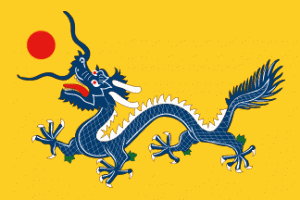
Empire of China
Quick reference
General issues: Customs office 1878-1897, Empire 1897-1912
Country name on general issues: China, Imperial Chinese Post
Special issues:
- Local issues: Amoy 1895-1896, Chefoo 1893-1896, Chinkiang 1893-1896, Chungking 1895-1895, Foochow 1895-1896, Formosa 1887-1888, Hankow 1893-1897, Ichang 1894-1896, Kiukiang 1894-1896, Nanking 1896-1897, Shanghai 1865-1897, Wuhu 1895-1897
- Foreign offices:
- France 1894-1922
- French Indochina
- General issues 1902-1905
- Canton 1901-1919, Chungking 1902-1919, Hoihow 1901-1919, Kwangchow 1906-1945, Mengtz 1906-1919, Pakhoi 1906-1919, Yunnanfu 1906-1919
- Germany 1898-1919
- General issues 1898-1919
- Foochow 1900, Tientsin 1900
- Kiaochow 1898-1919
- Great-Britain 1917-1930
- Italy
- Peking 1917-1922
- Tientsin 1917-1922
- Japan 1900-1922
- Russia 1899-1920
- General issues 1899-1920
- Harbin 1920
- United States 1919-1922
- Formosa: Black Flag Republic 1895
- China Expeditionary Force 1900-1921
- Chinese offices in Tibet 1911
Currency: 1 Tael= 100 Candarin 1857-1896, 1 Dollar/Yuan = 100 Cent 1896-1912
Population: 400 000 000 in 1900
Political history Chinese Empire
The Qing dynasty
China has been an empire for over 2000 years, ruled by several subsequent imperial dynasties. The last of these dynasties is the Qing dynasty that came to power in 1644. The golden age of the Qing lies in the 18th century. In the 19th century, the Qing are confronted with several large scale uprisings. Between 1850 and 1864, the Taiping uprising costing millions of lives. In 1900, the Boxer rebellion leading to an international intervention. Forces from eight foreign countries among whom British India were part of the international coalition forces. Finally, in 1911 the Wuchang uprising leads to the fall of the Qing dynasty and the end of the empire.
Furthermore, China is confronted with the strive for independence among some of the many peoples living within its the borders. One of those peoples are the Tibetans. In 1909, the Qing send an expeditionary force to Tibet to restore their power. After the fall of the Qing dynasty, in 1912, these troops are withdrawn and Tibet proclaims its independence. An independence that China does not recognize, but it will take until 1950 before effective Chinese rule in Tibet is restored.
Extraterritorial rights: Treaty ports and Concessions

The Great Wall of China
In the 19th century, the Qing also faced the demands of several foreign powers that require China to open up to diplomatic relations and trade. To further this cause, Great Britain, and later France, enter into the First and Second Opium wars between 1839 and 186o. The international pressure leads to the establishment of diplomatic relations and to the opening of over 40 ports for international trade, the so called ‘treaty ports’.[1]Sources differ on the number of treaty ports, quoted are Wellsted, Rossiter and Flower, The Stamp Atlas. In addition to the treaty ports, China grants extraterritorial rights to foreign powers in a number of forms. China allows foreign settlement in so called concessions in which the foreign powers had the right to establish their own political and legal administration. In some cities – Peking, Shanghai, Tienstin – several such concessions existed. Furthermore, territories were leased to foreign powers for a certain – mostly long – term: to the British parts of Hong Kong and Weihaiwei, to the French Kwangchow, to the Germans Kiaochow and to the Russians[2]Later Japanese and finally again Russian. – Kwantung. Finally, China had to allow two colonies on it soil. Hong Kong – transferred to the British after the First Opium war in 1842 – and Macau – a Portuguese leased territory since 1557 and a colony since 1887. The first foreign power to relinquish its extraterritorial rights in China is Germany, in 1917, as result of WWI. Gradually all extraterritorial rights are relinquished, the last territory – with the exception of the colonies -to be returned to China being Kwantung, returned by Russia in 1952. The colonies on Chinese soil are returned to China in 1997 – Hong Kong – and 1999 – Macau.
Japanese and Russian expansion
The expansionist policies of Japan lead to the First Sino-Japanese war from 1894 to 1895. The war ends in victory for Japan. China cedes its rights in Korea and Korea becomes part of the Japanese sphere of influence. China also cedes Formosa[3]The current Taiwan. that becomes an integral part of the Japanese empire. The cession of Formosa leads to the proclamation of the short lived Black Flag Republic in 1895 as a protest to Japanese annexation. The Black Flag Republic was extinguished by the Japanese in the year it was proclaimed.
Russia acquires extraterritorial rights in Mongolia and Manchuria. In Manchuria, Russia builds railways as an extension of the Trans Siberian Railway to connect Russia, through Manchuria, with Vladivostok and the Russian naval port of Port Arthur in the Russian concession of Kwantung. After the Boxer rebellion, Russia occupies Manchuria in 1900 which leads to the Russo-Japanese war. This war, like the Sino-Japanese war, ends in victory for the Japanese. The Russians cede their rights in Manchuria to the Japanese and Manchuria also becomes part of the Japanese sphere of influence.
Postal history Chinese Empire
Local issues
The first stamps to be issued in China were issued in 1865 by the municipality of Shanghai that had set up a local postal service in 1854. A service that branched out to 16 cities. In the 1890’s, several other cities – treaty ports – equally set up local postal services. These cities were: Amoy, Chefoo, Chinkiang, Chungking, Foochow, Hankow, Ichang, Kiukiang, Nanking and Wuhu. The services in Amoy, Foochow, Hankow and Nanking succeeded branch offices of the Shanghai local post. On Formosa, the local governor set up a postal service in 1887 for which stamps were also issued.[4]All catalogs list the Shanghai issues, the other local issues are listed by Michel, the Formosa issues also in Yvert.
Imperial Post
In addition to the local initiatives, the Imperial Maritime Customs Office in Shanghai set up a postal service in 1865 initially for consular mail, a service that branched out to 12 cities. In 1878, this service was opened to the general public and from that time stamps were issued. In 1896, by Imperial Decree, the Customs Post was transformed to the national Imperial Post, the decree being effective as of 1897. The first stamps were issued by the Imperial Post on January 2nd, 1897. These were overprints on the issues of the Customs Post, the overprint reading ‘Imperial Post’ and the new face value – with the introduction of the Imperial Post the currency used changed from Tael/Candarin to Dollar/Cent. The first definitive issues from the Imperial Post appeared in August 1897. Upon the introduction of the Imperial Post, all local postal services were superseded by the Imperial Post. The issues of the Imperial post are succeeded by those of the Republic of China and those of the Peoples Republic of China.
Foreign post offices
Aside from the local, and later imperial postal services in China, several foreign countries had offices abroad in China. These resulted from the agreements on extraterritorial rights signed in the course of the 19th century. The post offices first served the interests of the respective foreign powers. They, however, also processed all international mail from China until China joined the UPU in 1914. For this purpose the stamps used by the foreign offices were also available at offices of the Imperial Chinese post. The currency used would be that of the foreign nation or the local Chinese currency. The stamps used at these foreign offices were those of the respective countries, with or without an overprint for the use in the offices in China. The Russian offices in China closed in 1920. The other foreign offices closed in 1922, with the exception of the post offices in the leased territories which closed at the time these were returned to China.
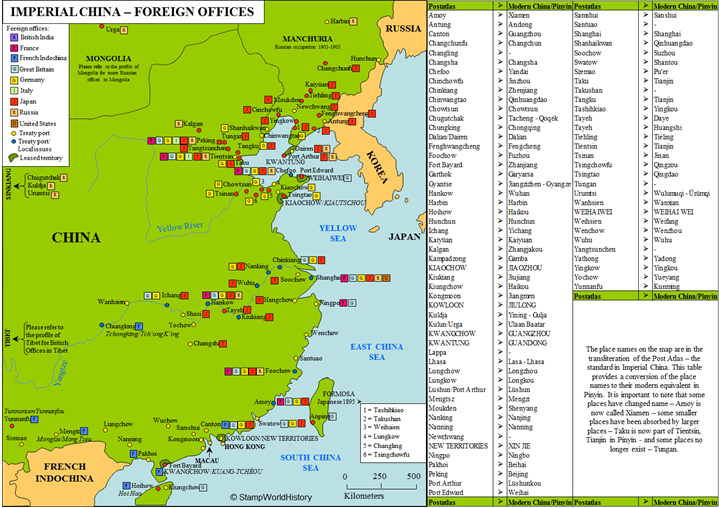
Please click on the image to enlarge, please click here for the PDF version of the image
A closer look at the foreign post offices
A closer look at the offices abroad of the respective countries provides the following:
- France: The first French post office opened in 1867 in Shanghai. The French offices first used stamps of France and, from 1894, definitives issued for use in China inscribed with ‘Chine’. The French offices closed in 1922.
-
French Indochina: In 1901, the French offices in southern China were subordinated to the postal authorities of French Indochina. The Indochinese offices closed in 1922, with the exception of those in the French leased territory of Kwangchow that closed when Kwangchow was returned to China in 1945. The Indochinese offices in China used stamps as follows:
- General issues being overprints on stamps of French Indochina reading ‘Chine’ and the new face value in Chinese characters.
- Issues for individual offices being stamps of French Indochina with the following overprints:
- Canton: Canton
- Chungking: Tchongking or Tch’ong K’ing
- Hoihao: Hoi Hao or Hoi-Hoa
- Kwangchow: Kouangtschéou or Kouang-Tschéou and as of 1939 definitives inscribed Kouang-Tschéou
- Mengtz: Mongtze or Mong-Tseu
- Pakhoi: Packhoi, Pak Hoi or Pak-Hoi
- Yunnafu: Yunnansen, Yunnan-Fou or Yunnanfou
-
Germany:
- General issues: The first German post office opened in 1886. Stamps of Germany were used and, from 1898, German stamps overprinted ‘China’. The German offices were closed in 1917 upon China’s entry into WWI. Stamps were issued until 1919, even after the German offices were closed.
- Foochow: The office in Foochow issued local hand stamped overprints with a new face value in 1900.
- Tientsin: The Tientsin office issued local hand stamped overprints in 1900, the overprint reading ‘China’.
- Kiaochow: Kiaochow – or Kiautschou in the German transliteration – was a German leased territory from 1897. Kiaochow first used stamps of Germany, then the general issues for the German offices in China. The office in Kiaochow issued local overprints with a new face value in 1900. As of 1901, definitives were issued inscribed ‘Kiautschou’. Kiaochow was occupied by the Japanese in 1914 upon which the German offices closed. Kiaochow was returned to China in 1922.
- Great Britain: The first British post office opened in 1844. From 1862, stamps of Hong Kong were used and from 1917, stamps of Hong Kong overprinted ‘China’. The British offices were closed in 1922 with the exception of Weihaiwei – a British leased territory – which was returned to China in 1930.
- Italy: The Italian post offices were opened in 1917 in Peking and Tientsin. Stamps of Italy with the overprints ‘Pechino’ and ‘Tientsin’ were issued. The Italian offices were closed in 1922.
- Japan: The first Japanese offices opened in 1876. Initially, Japanese stamps were used, followed in 1900 by stamps from Japan overprinted ‘China’ in Japanese. The Japanese offices closed in 1922.
-
Russia
- General issues: The first Russian offices opened in 1870. Russian stamps were used until 1899 when stamps were issued for the offices in China. These were Russian stamps overprinted ‘KИTAЙ'[5]‘China’ and overprints with just the face value in the local currency. The Russian offices were closed in 1920.
- Harbin: The ‘Harbin issue’ was a set of stamps issued in 1920 on behalf of the Chinese Eastern Railway in Manchuria – a railway built and exploited by the Russians. The issue is an overprint in the local currency on Russian stamps.
- United States: The United States post office in Shanghai opened in 1867. Stamps of the United States were used until 1919 when stamps of the United States overprinted ‘Shanghai China’ and the face value in the local currency were issued. The United States office was closed in 1922.
Formosa: The Black Flag Republic
After the establishment of the Black Flag Republic on Formosa in opposition to the Japanese annexation of the island, two sets of stamps were issued in 1895. After the Black Flag Republic was dissolved by the Japanese, these stamps were superseded by the stamps of Japan. The stamps of Japan have been used on Formosa until it was returned to China in 1945.[6]These issues are listed by Michel, not by the other catalogs.
China Expeditionary Force
Stamps were issued by British India for use by the China Expeditionary Force that intervened in China during the Boxer rebellion. The stamps are overprints of British India stamps reading ‘C.E.F.’. The stamps are issued between 1900 and 1921. The larger part of the China Expeditionary Force left China in 1906, a smaller contingent stayed until 1923.
Chinese offices in Tibet
After the Chinese had sent their troops to Tibet in 1909 to restore Chinese rule, they set up a postal service in Tibet. Initially, stamps of China were used. In 1911, stamps were issued with an overprint in Chinese, English and Tibetan indicating the face value of the stamps. The currency used was the British Idian Rupee/Anna. It has been suggested that this may have been because the Indian rupee was the most popular currency in Tibet.
A note on transliteration
As China opened up to the Western world in the 19th century, several different systems have been developed for the transliteration of Chinese to the Latin alphabet. This resulted in different transliterations of the same words. For example 重庆 – a city in China – transliterated to English becomes Chungking and to French it becomes Tch’ong K’ing. The Chinese postal authorities recognized this as a problem and introduced, in the early 20th century, the Post Atlas as a standard for the transliteration of place names. The Post Atlas is largely based on the Wade-Giles system for transliteration, Wade-Giles being the most used system in the Anglo-Saxon world. In the second part of the 20th century the Peoples Republic of China developed a new system which aimed to replace all existing systems and become the worldwide standard for transliteration of the Chinese language. The system is called Hanyu Pinyin or Pinyin. In pinyin 重庆 transliterates to Chongqing. Pinyin has, by the end of the 20th century, largely succeeded in becoming the aimed at international standard. This being so, historians often use either Wade-Giles or pinyin depending on the period of their studies. They do so for the recognizability of names and place names in the historical context of the period of their studies. On this site I follow suit and use the Post Atlas for profiles of the Chinese Empire and the Republic of China and pinyin for the profile of the Peoples Republic of China.
Album pages
← Previous page: CeylonNext page: China - Peoples Republic →

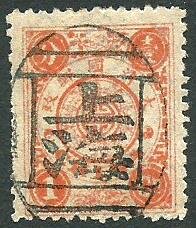
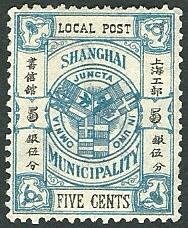
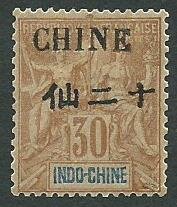
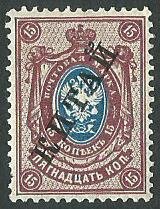
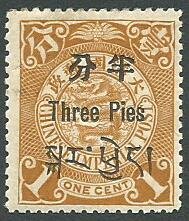








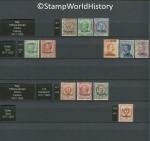
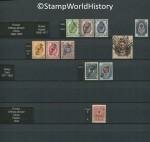
Russia post in China. The overprints on the stamps are not „KHTAЙ“ but „KИTAЙ“. Gedi
Gedi, thanks again. Sorry for my late response – thanks for your persistence in getting this reply through. Somehow (?) your reply was marked as spam – which I do not check every day.